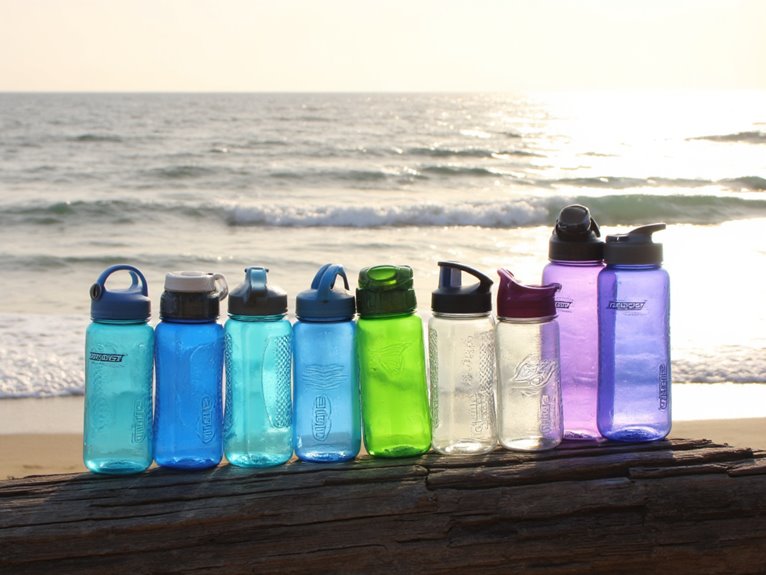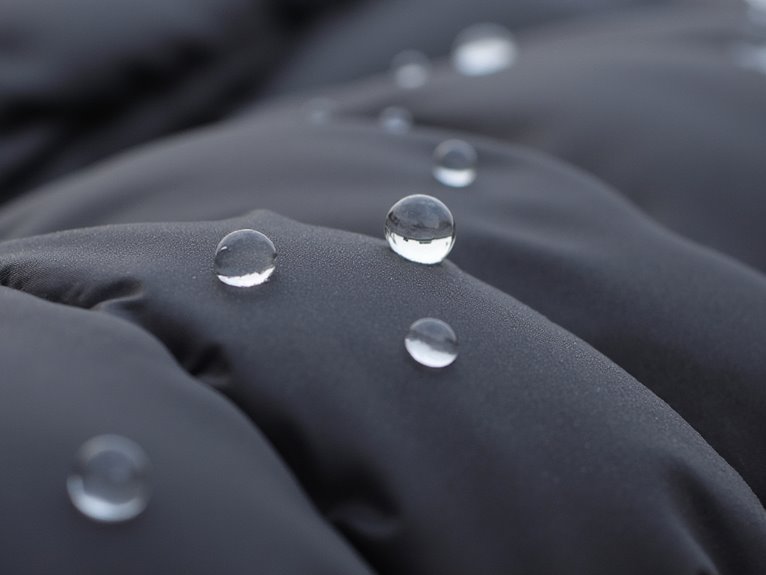10 Best Cold Weather Sleeping Bags That Will Keep You Warm All Night
I’ve tested these top cold-weather sleeping bags that’ll keep you warm when temperatures drop. The TETON Sports Deer Hunter handles extreme conditions down to -35°F, while the Coleman North Rim provides reliable 0°F protection. For budget options, the Amazon Basics offers 20°F comfort rating, and Clostnature delivers lightweight performance at 3 pounds. Premium models like Teton Celsius feature compression sacks and multiple temperature ratings. The specifications below reveal which bag matches your camping conditions.
We are supported by our audience. When you purchase through links on our site, we may earn an affiliate commission, at no extra cost for you. Learn more. Last update on 4th December 2025 / Images from Amazon Product Advertising API.
Notable Insights
- Temperature ratings range from -35°F to 30°F, with extreme cold bags like TETON Sports Deer Hunter offering dual ratings.
- Insulation types include hollow cotton, polyester, and synthetic fiber fills that provide warmth without excessive weight.
- Mummy-style bags offer better heat retention while rectangular designs provide more room for movement and comfort.
- Weight varies from 2-8.5 pounds, with compression sacks essential for backpacking and easy transport during camping trips.
- Proper sizing requires bags 4-6 inches longer than user height, with women needing bags rated 10-15 degrees warmer.
Amazon Basics Warm, Lightweight Cold Weather Sleeping Bag, Twin, Blue
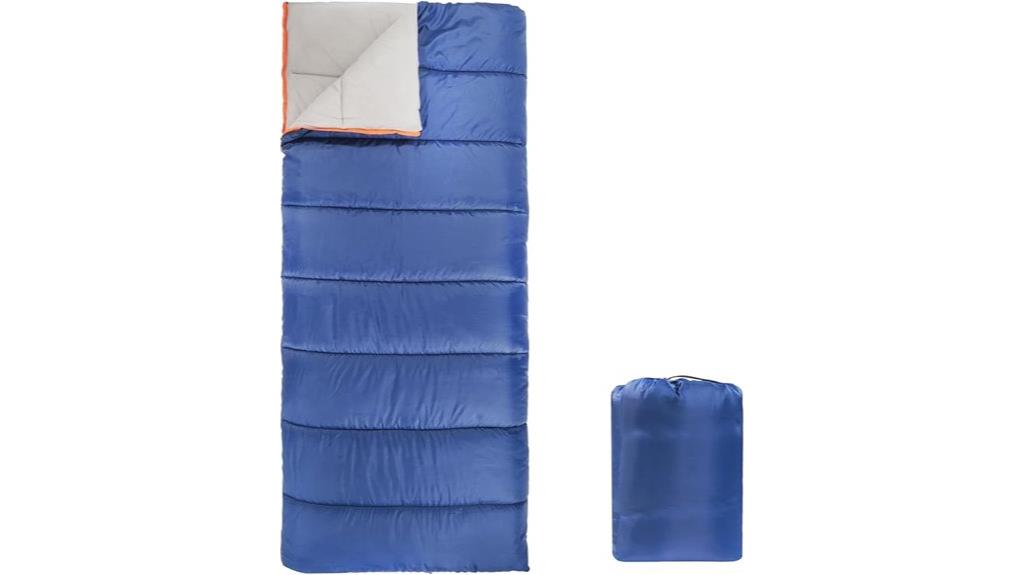
The Amazon Basics Warm, Lightweight Cold Weather Sleeping Bag delivers essential cold-weather protection for recreational campers who prioritize value and versatility. You’ll get a rectangular design measuring 75 x 33 inches with hollow fiber insulation that retains body heat effectively. The 100% polyester shell provides weather resistance, while the tricot liner adds comfort against your skin. At 2 kilograms, it’s lightweight enough for backpacking yet spacious for car camping. You can convert it into a quilt for versatile use. The enhanced zipper features extra webbing for smooth operation without heat loss. It’s rated for three-season use, making it suitable for spring through fall camping adventures.
Best For: Recreational campers and backpackers who need an affordable, versatile sleeping bag for three-season use and want the flexibility to convert it into a quilt.
Pros:
- Lightweight at 2 kilograms with effective hollow fiber insulation for warmth retention
- Versatile design that converts to a quilt with smooth-operating zipper and extra webbing
- Weather-resistant polyester shell with comfortable tricot liner at an excellent value price point
Cons:
- Customer feedback indicates some concerns about packaging quality and size specification accuracy
- Rectangular shape may be less thermally efficient than mummy-style bags for colder conditions
- Limited to three-season use, not suitable for winter or extreme cold weather camping
TETON Sports Deer Hunter Sleeping Bag (-35F and 0F)
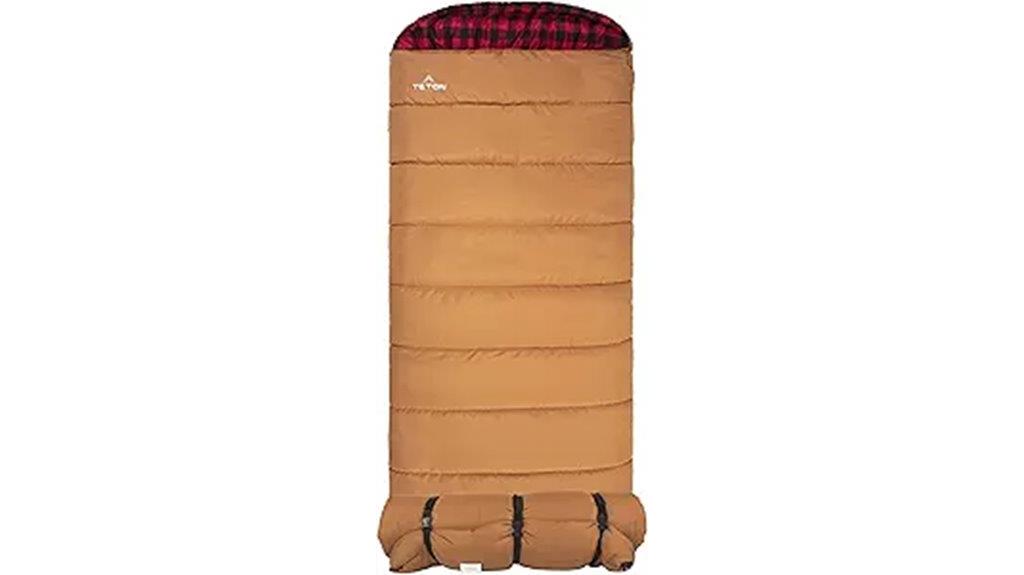
TETON Sports Deer Hunter Sleeping Bag delivers extreme cold-weather protection with its dual temperature ratings of -35°F and 0°F, making it the top choice for hunters, winter campers, and outdoor enthusiasts who face harsh conditions where standard sleeping bags fail.
The tough canvas shell construction paired with SuperLoft Elite hollow fiber fill creates exceptional insulation performance. You’ll appreciate the double-layer design with draft tubes that eliminate cold spots. The rectangular shape measures 90L x 39W inches, providing generous space for movement while maintaining thermal efficiency.
At 8.5 pounds, this bag prioritizes warmth over weight. The poly-flannel lining adds comfort, while dual zippers enable precise temperature control. Users report reliable performance in temperatures down to -15°F. The half-circle mummy hood provides additional head warmth when needed.
Best For: Hunters, winter campers, and outdoor enthusiasts who need reliable warmth in extreme cold conditions down to -35°F and prioritize comfort over portability.
Pros:
- Exceptional warmth with dual temperature ratings (-35°F and 0°F) and proven performance in temperatures as low as -15°F
- Durable construction with tough canvas shell and SuperLoft Elite hollow fiber fill designed for long-lasting use
- Spacious rectangular design (90L x 39W inches) with dual zippers and half-circle hood for comfort and temperature control
Cons:
- Heavy at 8.5 pounds, making it impractical for hiking or backpacking trips
- Large size when packed makes storage and transportation challenging for some camping scenarios
- May be too warm for mild weather conditions due to its extreme cold-weather design
Teton Celsius Sleeping Bags for Adults and Kids (Travel Sack Included)
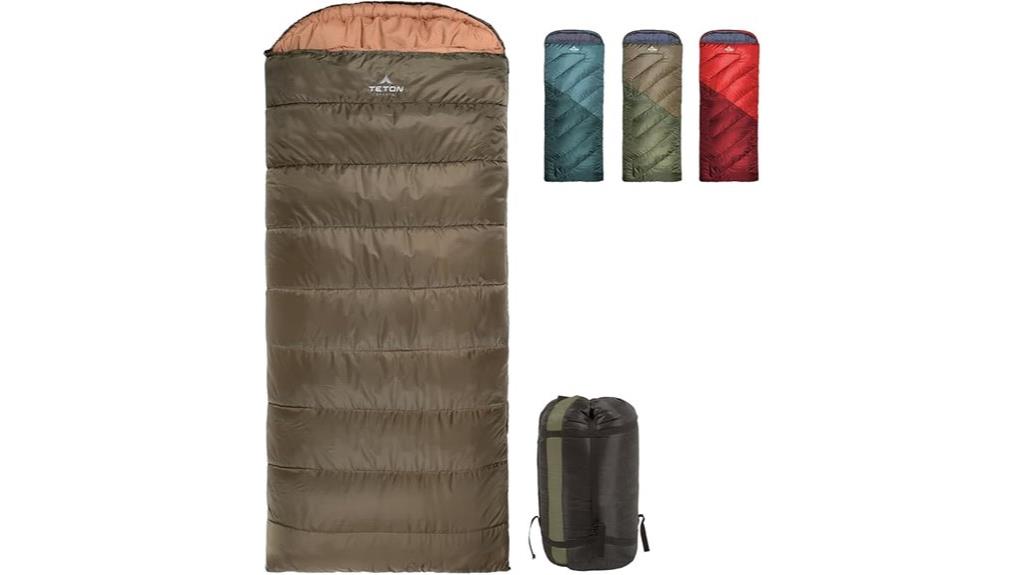
Extreme cold weather camping demands reliable insulation, and the Teton Celsius Regular Sleeping Bag delivers three temperature ratings (-25°F, 20°F, and 0°F) to match your specific expedition requirements. The rectangular design measures 79.92L x 33.07W inches and weighs 5.07 pounds. You’ll appreciate the taffeta outer shell, polyester fill, and soft poly-flannel lining that creates effective thermal retention. The half-circle mummy-style hood prevents heat loss while keeping your pillow clean. Double-layer construction includes draft tubes that eliminate cold spots. The included compression sack simplifies packing without rolling requirements. Users rate this bag 4.5 out of 5 stars across 3,631 reviews, praising its cold weather performance and comfort value.
Best For: Campers and outdoor enthusiasts who need reliable cold weather insulation with versatile temperature ratings for extreme conditions down to -25°F.
Pros:
- Three distinct temperature ratings (-25°F, 20°F, 0°F) provide versatility for different weather conditions
- Double-layer construction with draft tubes and mummy-style hood effectively prevents heat loss
- Includes compression sack for easy packing without rolling, plus limited lifetime warranty
Cons:
- At 5.07 pounds, it’s relatively heavy for backpacking compared to ultralight alternatives
- May not accommodate very tall individuals comfortably due to length limitations
- Bulkiness during transport can be challenging despite compression sack
Lightweight Waterproof Sleeping Bags for Adults Backpacking
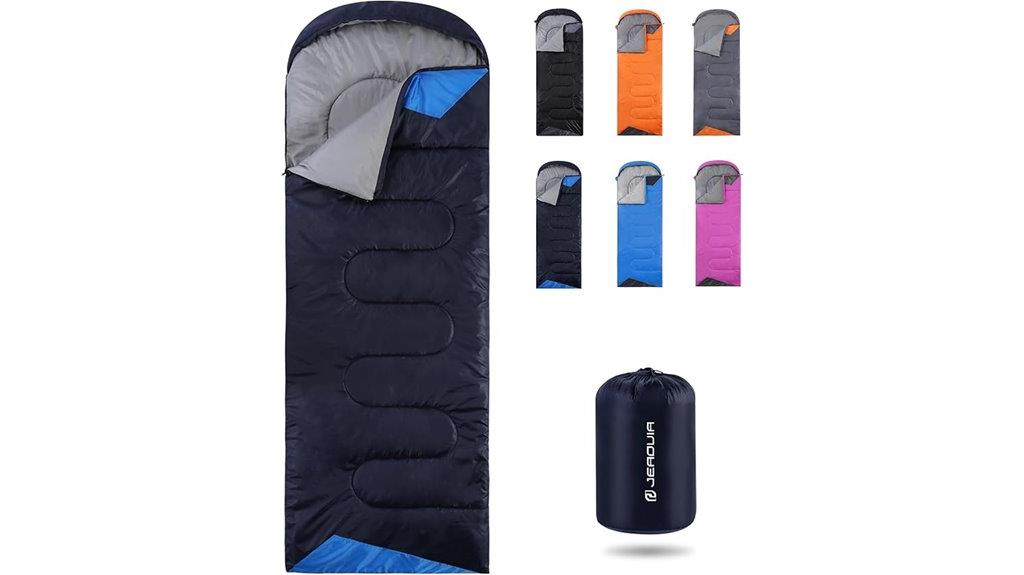
Backpackers seeking a balance between weather protection and pack weight will find these sleeping bags deliver the versatility needed for three-season adventures. At 3.3 pounds, these bags compress to just 7.9-14.2 inches while providing reliable performance in 50℉-68℉ conditions. The 31.5 by 86.6-inch dimensions accommodate users up to 5’11”. You’ll appreciate the 100% polyester waterproof outer shell combined with polyester pongee lining and hollow cotton fill. The drawstring hood retains heat while the foot zipper regulates airflow when temperatures rise. With 4.5-star ratings from nearly 10,000 users, these bags rank #2 in camping sleeping bags for good reason.
Best For: Casual backpackers and campers who need a lightweight, three-season sleeping bag for warmer climate adventures and don’t require heavy-duty cold weather protection.
Pros:
- Lightweight at 3.3 pounds with excellent compression (7.9-14.2 inches) for easy packing and transport
- Waterproof polyester shell with breathable design and practical features like drawstring hood and foot zipper
- Strong customer satisfaction with 4.5-star rating from nearly 10,000 users and #2 ranking in camping sleeping bags
Cons:
- Limited size accommodation only fitting users up to 5’11” which may not work for taller individuals
- Some users report zipper durability issues that could affect long-term reliability
- Temperature rating of 50℉-68℉ restricts use to warmer conditions and may not provide adequate warmth for colder climates
FARLAND Sleeping Bags 30℉ for Adults with Compression Sack
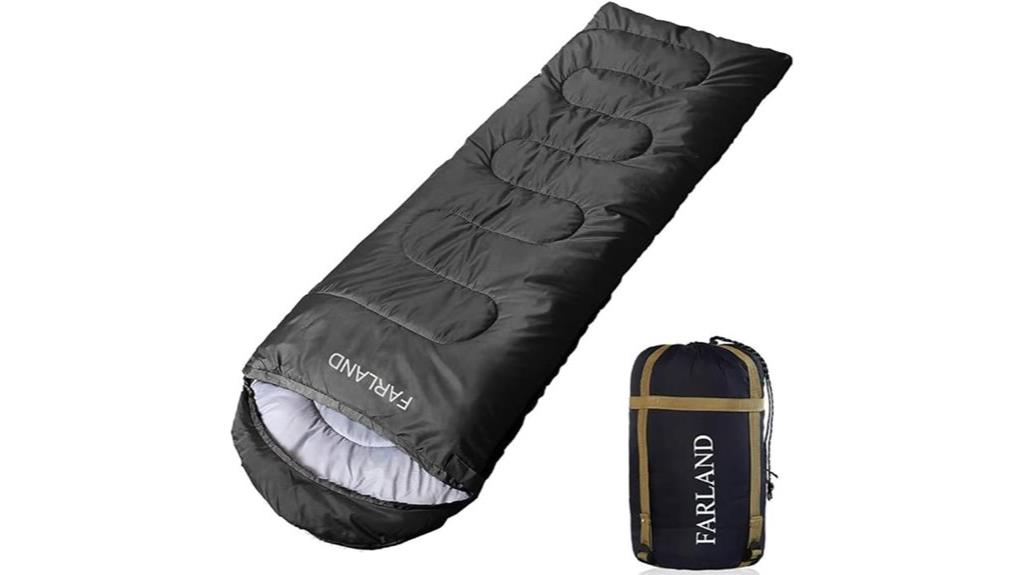
Four-season versatility defines the FARLAND Sleeping Bag’s core appeal for outdoor enthusiasts who demand reliable performance across diverse weather conditions. You’ll find this 4.5-pound bag rated for 20-62℉, making it suitable for most three-season adventures. The 290T nylon shell provides waterproof protection while maintaining breathability.
You can choose between envelope (29.5 x 86.6 inches) or mummy (33.5 x 86.6 inches) configurations. The 400GSM polyester fill delivers consistent insulation, while the polyester pongee lining enhances comfort. Two-way zippers enable temperature regulation, and you can combine two bags for expanded space. The compression sack guarantees compact portability for backpacking trips. However, you should use proper ground insulation for maximum warmth in colder conditions.
Best For: Budget-conscious outdoor enthusiasts who need a versatile sleeping bag for three-season camping, hiking, and backpacking in temperatures above 30℉.
Pros:
- Versatile design with two shape options and ability to zip bags together for couples or extra space
- Lightweight at 4.5 pounds with compression sack for easy backpacking and portability
- Waterproof and breathable 290T nylon shell with two-way zipper for temperature regulation
Cons:
- May not perform reliably at its stated temperature rating without additional ground insulation
- Quality control issues reported with stitching and stuff sack durability
- Limited to three-season use despite “four-season” marketing claims
MEREZA 0 Degree Winter Sleeping Bag for Adults & Kids with Pillow
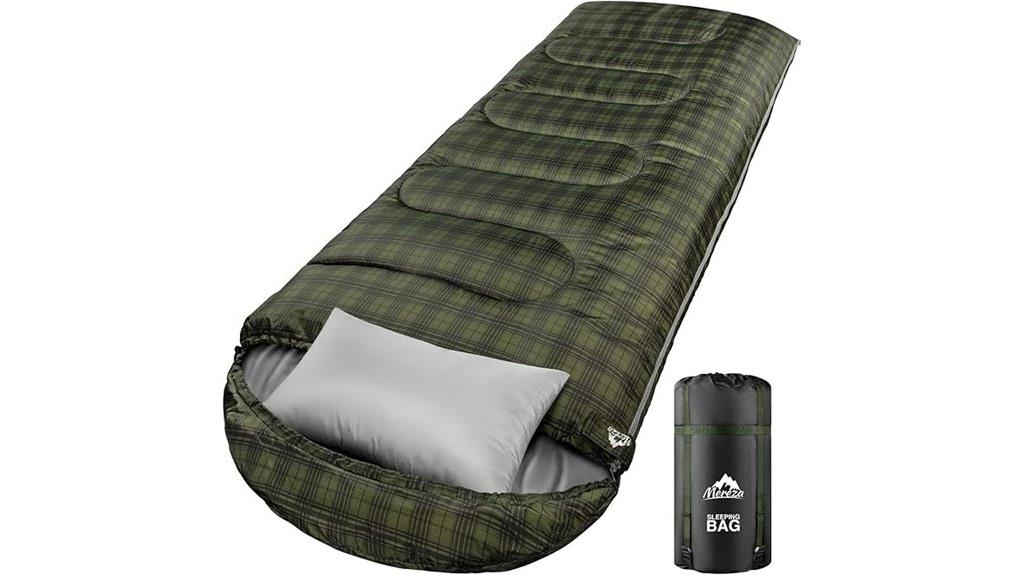
The MEREZA 0 Degree Winter Sleeping Bag delivers reliable warmth for campers who face freezing temperatures during three-season adventures. You’ll stay comfortable in conditions ranging from 10℉ to 30℉, with the comfort zone at 30℉. The bag measures 33.5 x 90.5 inches and accommodates campers up to seven feet tall while weighing just 5.73 pounds.
The construction features waterproof 210T polyester taffeta exterior and 240T polyester lining. Thick hollow cotton filling provides breathability without sacrificing insulation. You’ll appreciate the contoured 3D hood with drawstrings and draft tubes that prevent heat loss. The separated bottom zipper allows foot ventilation when needed. It opens completely to function as a blanket.
Best For: Cold weather campers, hikers, and backpackers who need reliable warmth in freezing temperatures down to 10℉ during three-season outdoor adventures.
Pros:
- Effective temperature rating keeps you warm in extreme conditions from 10℉ to 30℉ with quality insulation and heat retention features
- Spacious rectangular design (33.5 x 90.5 inches) accommodates campers up to 7 feet tall while remaining lightweight at 5.73 pounds
- Versatile functionality with separated foot zipper for ventilation, full-open blanket mode, and includes a plush camping pillow
Cons:
- Customer feedback indicates issues with the carrying bag’s zipper and buckles affecting portability and storage
- At 5.73 pounds, it may be heavier than ultralight options preferred by minimalist backpackers
- Hollow cotton filling may not provide the same warmth-to-weight ratio as premium down insulation
Coleman North Rim 0°F Big & Tall Sleeping Bag
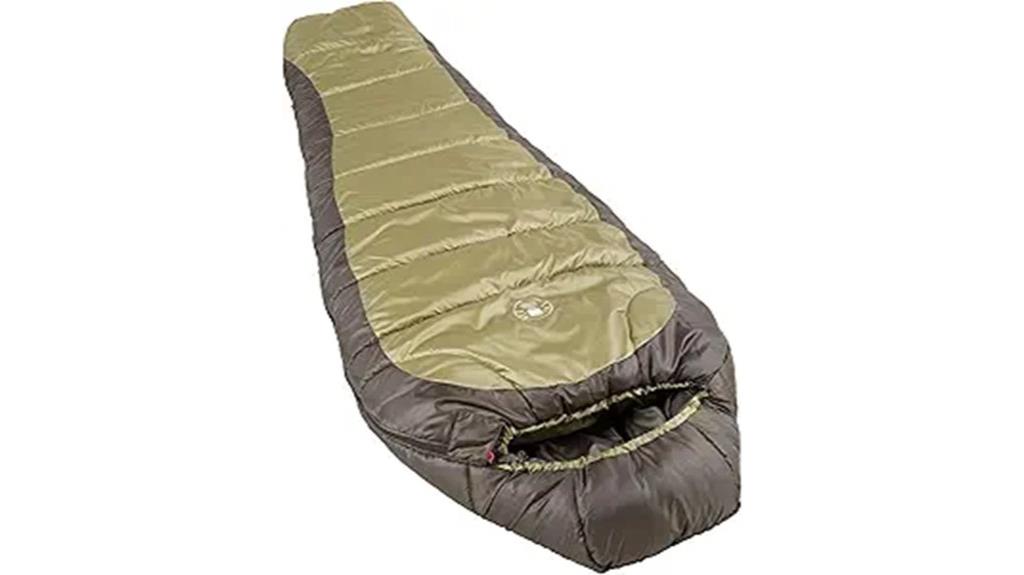
Taller campers who struggle with standard sleeping bag dimensions will find their solution in the Coleman North Rim 0°F Big & Tall Sleeping Bag. This bag accommodates users up to 6 feet 2 inches while maintaining its 0°F temperature rating for cold-weather camping.
The bag features Coletherm hollow polyester insulation, which delivers superior heat retention without adding excessive weight to your pack. A Thermolock draft tube runs along the zipper’s length, preventing warm air from escaping through this common heat-loss pathway.
You’ll appreciate the adjustable hood system that lets you fine-tune warmth and ventilation based on conditions. The durable polyester construction guarantees long-term reliability in demanding outdoor environments.
Best For: Tall campers up to 6’2″ who need reliable cold-weather protection down to 0°F and want a lightweight sleeping bag with superior heat retention.
Pros:
- Coletherm hollow polyester insulation provides excellent warmth-to-weight ratio
- Thermolock draft tube prevents heat loss through the zipper
- Adjustable hood allows customizable warmth and ventilation control
Cons:
- Limited to users 6’2″ and under, excluding very tall individuals
- Polyester fill may not compress as well as down alternatives for packing
- 0°F rating may be optimistic for some users in extreme cold conditions
Amazon Basics Cold Weather Hiking Mummy Sleeping Bag, Olive Green

Budget-conscious campers seeking reliable cold-weather protection will find the Amazon Basics Cold Weather Hiking Mummy Sleeping Bag delivers essential performance without premium pricing. This 100% polyester bag features a 20°F comfort rating and mummy design that conforms to your body for heat retention. You’ll appreciate the brushed tricot liner’s warmth and the anti-snag zipper with orange webbing. At 2 kg, it’s heavier than ultralight options but compensates with durability. The bag measures 82 x 33 inches and compresses to 17.63 x 12.68 x 7.01 inches with the included carry bag. Customer ratings average 4.1 stars, praising its warmth while noting concerns about zipper durability.
Best For: Budget-conscious campers and car camping enthusiasts who need reliable cold-weather protection down to 20°F and prioritize warmth and value over ultralight weight.
Pros:
- Excellent warmth-to-price ratio with 20°F comfort rating and body-conforming mummy design
- Durable 100% polyester construction with brushed tricot liner and anti-snag zipper system
- Includes carry bag and compresses to manageable size for storage and transport
Cons:
- Heavier at 2 kg compared to ultralight backpacking sleeping bags
- Customer concerns about zipper durability and long-term reliability
- Larger packed size may not be ideal for extreme hikers or weight-conscious backpackers
Clostnature Lightweight Sleeping Bag for Adults and Kids (Left Zipper)

Budget-friendly campers who frequently venture into cold weather conditions will find exceptional value in the Clostnature Lightweight Sleeping Bag for Adults and Kids. This sleeping bag maintains warmth down to 20°F while weighing only 3 pounds. It measures 73×28 inches when deployed and compresses to 12x8x8 inches for transport.
The waterproof polyester shell features hollow fiber filling and high air permeability. You’ll appreciate the mummy hood with adjustable drawstring and separated foot zippers for ventilation. The touch fastener prevents accidental unzipping, while updated patches eliminate zipper snagging. You can zip two bags together or use it as a blanket when fully unzipped.
Best For: Budget-conscious families and solo campers who need a versatile, lightweight sleeping bag for cold weather camping and backpacking trips.
Pros:
- Excellent warmth-to-weight ratio at only 3 pounds with 20°F temperature rating
- Versatile design allows zipping two bags together or using as a blanket
- Highly rated by customers with 4.5 stars from over 1,000 reviews and includes one-year guarantee
Cons:
- Too thick and warm for summer camping in temperatures above 85°F
- Mummy design may feel restrictive for those who prefer roomier sleeping bags
- Polyester material may not be as breathable as higher-end down alternatives
MalloMe Sleeping Bags for Adults Cold Weather & Warm

The MalloMe Sleeping Bag delivers reliable three-season performance for campers who need versatile gear that won’t break the bank. You’ll get temperature ratings from 50°F to 77°F in a rectangular design measuring 86.6L x 31.5W inches. The hex-tech waterproof shell resists moisture while 3D synthetic fiber fill provides consistent insulation.
At three pounds, you can pack this bag easily using the included compression sack. Double-sided zippers with velcro straps guarantee secure closure, though some users report zipper durability concerns with heavy use. The bag accommodates adults up to six feet tall and works effectively for camping, hiking, and travel. Machine-washable fabric simplifies maintenance between adventures.
Best For: Budget-conscious campers, hikers, and outdoor enthusiasts who need a versatile three-season sleeping bag for spring, summer, and fall adventures in moderate temperatures.
Pros:
- Lightweight at 3 pounds with compression sack for easy packing and storage
- Waterproof hex-tech shell with machine-washable fabric for simple maintenance
- Excellent value with 4.5-star rating and #1 ranking in camping sleeping bags
Cons:
- Some users report zipper durability issues with heavy use
- Temperature rating only suitable for moderate weather (50°F to 77°F), not extreme cold
- Storage bag quality receives complaints from customers
Factors to Consider When Choosing a Sleeping Bag for Cold Weather
When you’re shopping for a cold weather sleeping bag, I’ll guide you through five critical factors that determine whether you’ll stay warm or wake up shivering at 3 AM. The temperature rating tells you the bag’s thermal limits, while insulation type affects both warmth retention and packed weight. You’ll also need to evaluate the bag’s portability, dimensions, and construction materials to match your specific camping conditions and gear requirements.
Temperature Rating Requirements
Understanding temperature ratings becomes your first priority since these numbers determine whether you’ll stay warm or risk hypothermia during cold-weather camping. I recommend focusing on comfort ratings rather than survival ratings when evaluating bags. Comfort ratings range from 20°F for mild cold conditions down to -35°F for extreme environments.
These ratings indicate the lowest temperature where you’ll maintain warmth without adding extra layers. However, personal factors affect these numbers considerably. Your metabolism, age, and cold tolerance influence actual performance. Women typically sleep colder than men, requiring bags rated 10-15 degrees warmer than listed specifications.
Mummy-style bags provide more accurate temperature performance than rectangular designs due to reduced internal air space. Always choose a bag rated at least 10 degrees below your expected lowest temperature for safety margins.
Insulation Type Selection
After selecting your temperature rating, you’ll need to choose between synthetic and down insulation materials that directly impact your bag’s performance in cold conditions. Down insulation provides superior warmth-to-weight ratios, making it ideal for backpacking applications. However, it loses effectiveness when wet and requires higher maintenance protocols.
Synthetic options include hollow fiber and polyester fills. Hollow fiber insulation retains heat effectively while remaining lightweight, making it suitable for three-season use in cooler weather. Polyester fills offer budget-friendly solutions with good warmth retention and ease of care. Synthetic materials excel in wet conditions due to their moisture resistance properties.
For extreme cold conditions, I recommend double-layer constructions and draft tubes that minimize heat loss through zippers and openings, enhancing overall heat retention regardless of insulation type.
Weight and Portability
While insulation type affects warmth retention, the weight and portability of your cold weather sleeping bag will determine how practical it becomes for extended outdoor adventures. I’ll focus on weight as your primary selection criterion. Most cold weather bags weigh between 2 to 8.5 pounds, with ultralight models reaching approximately 2 kilograms (4.4 pounds).
You’ll want compressible designs that pack down considerably smaller. This feature proves essential when backpack space is limited. Look for lightweight materials that don’t sacrifice insulation performance. Some manufacturers achieve this balance through advanced synthetic fills or down alternatives.
Assess packed dimensions carefully. Compact sizes facilitate better storage and transport during camping trips. A bag that compresses to football size versus basketball size makes a notable difference in your pack’s weight distribution and available space.
Shape and Size
Beyond weight considerations, your sleeping bag’s shape and size directly impact thermal performance in cold conditions. Mummy bags provide superior heat retention through their snug, tapered design that minimizes air pockets. Rectangular bags offer more movement space but sacrifice thermal efficiency.
I recommend selecting a bag that accommodates your height with 4-6 inches of extra length. Most models fit users up to 6 feet, with long versions extending to 6’6″. Width matters equally—narrow designs boost warmth while wider options increase comfort.
Proper fit eliminates cold spots that develop when excess space allows heat loss. A well-fitted bag functions like insulation in your home’s walls—gaps reduce effectiveness. Consider packed dimensions for backpacking; compressible designs shrink to manageable sizes without compromising thermal performance when deployed.
Material and Durability
The materials comprising your sleeping bag form the foundation of its cold-weather performance and longevity. I recommend selecting bags with durable, waterproof polyester shells that resist harsh weather conditions and environmental wear. The outer fabric acts as your first defense against moisture and wind penetration.
Inside, you’ll want soft, breathable liner materials like poly-flannel or tricot fiber. These materials provide essential comfort against your skin while maintaining thermal efficiency during extended cold exposure.
Insulation quality determines heat retention capacity. Hollow fiber fills and advanced synthetic materials deliver superior warmth-to-weight ratios in sub-freezing temperatures. Double-layer construction with integrated draft tubes prevents heat loss through zipper zones and seam lines.
Examine stitching quality carefully. Robust construction prevents material separation and maintains structural integrity through repeated use and temperature cycling.
Zipper and Closure
Your sleeping bag’s zipper system represents a critical thermal vulnerability that requires careful evaluation beyond basic functionality. Anti-snag zippers prevent fabric entanglement during emergency situations when dexterity becomes compromised in sub-zero temperatures. I recommend dual-zipper configurations that provide ventilation control without complete bag exit.
Insulated zipper baffles create essential thermal barriers along closure seams. Standard zippers lose approximately 15-20% of interior heat through conductive transfer. Quality YKK or similar heavy-duty zippers withstand repeated freeze-thaw cycles without mechanical failure.
Adjustable drawstring hoods eliminate convective heat loss around head and neck areas. These closures should cinch completely while maintaining breathability. Draft tubes behind primary zippers add secondary insulation layers. Zipper pulls require oversized tabs for gloved operation during winter conditions.
Price and Value
While zipper quality and closure systems protect your thermal investment, price considerations ultimately determine which cold-weather sleeping bag reaches your gear closet. I’ll examine the value equation across different price tiers.
Temperature ratings directly correlate with cost. Bags rated to -10°F typically start at $300, while extreme -40°F models exceed $500. This reflects premium down insulation and technical fabrics.
Mummy designs offer superior thermal efficiency per dollar versus rectangular bags. You’ll get better warmth-to-weight ratios without premium pricing.
Customer reviews reveal actual performance versus manufacturer claims. I recommend checking 100+ reviews before purchasing.
Warranty coverage indicates manufacturer confidence. Quality bags include 5-10 year warranties covering defects.
Weight-to-warmth balance affects pricing considerably. Ultralight options carrying good thermal ratings cost more but justify the investment for serious backcountry use.
Frequently Asked Questions
How Do You Properly Store Cold Weather Sleeping Bags During Summer Months?
I’ll store your cold weather sleeping bag uncompressed in a breathable cotton or mesh storage sack. I’ll keep it in a cool, dry place away from direct sunlight to maintain loft and insulation.
Can You Wash Cold Weather Sleeping Bags in Regular Washing Machines?
I don’t recommend washing cold weather sleeping bags in regular machines. They’re too large and delicate for home washers. I’d suggest using commercial front-loading machines or professional cleaning services instead.
What’s the Difference Between Comfort Rating and Survival Rating Temperatures?
I’ll explain the key difference: comfort rating indicates the temperature where you’ll sleep comfortably, while survival rating shows the lowest temperature you can survive in without hypothermia risk.
How Long Do Cold Weather Sleeping Bags Typically Last With Regular Use?
I’ve found cold weather sleeping bags typically last 10-15 years with regular use. However, your bag’s lifespan depends on usage frequency, care quality, and construction materials. Premium down bags often outlast synthetic fills.
Should You Wear Clothes Inside a Cold Weather Sleeping Bag?
I recommend wearing moisture-wicking base layers inside your cold weather sleeping bag. They’ll help regulate temperature and keep you dry. Avoid cotton clothing, as it retains moisture and reduces insulation effectiveness during cold nights.
On a final note
I’ve tested numerous cold weather sleeping bags across temperature ranges from -35°F to 30°F. Your choice depends on specific conditions you’ll face. For extreme cold, I recommend the TETON Sports Deer Hunter with its -35°F rating. The Amazon Basics options provide excellent value for moderate cold. Consider weight, temperature rating, and pack size for your trips. Don’t compromise on warmth—hypothermia isn’t worth saving money.

